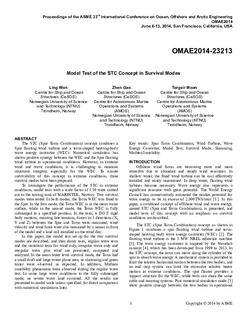| dc.description.abstract | The STC (Spar Torus Combination) concept combines a Spar floating wind turbine and a torus-shaped heaving-body wave energy converter (WEC). Numerical simulation has shown positive synergy between the WEC and the Spar floating wind turbine in operational conditions. However, in extreme wind and wave conditions, it is challenging to maintain structural integrity, especially for the WEC. To ensure survivability of this concept in extreme conditions, three survival modes have been proposed.
To investigate the performance of the STC in extreme conditions, model tests with a scale factor of 1:50 were carried out in the towing tank of MARINTEK, Norway. Two survival modes were tested. In both modes, the Torus WEC was fixed to the Spar. In the first mode, the Torus WEC is at the mean water surface, while in the second mode, the Torus WEC is fully submerged to a specified position. In the tests, 6 D.O.F rigid body motions, mooring line tensions, forces in 3 directions (X, Y and Z) between the Spar and Torus were measured, wind velocity and wind force were also measured by a sensor in front of the model and a load cell installed on the wind disc.
In this paper, the model test set-up for the two survival modes are described, and then decay tests, regular wave tests and the statistical tests for wind only, irregular wave only and irregular wave plus wind are presented, compared and analyzed. In the mean water level survival mode, the Torus had a small draft and large water plane area, so slamming and green water were observed as expected. In addition, Mathieu instability phenomena were observed during the regular wave test. In some large wave conditions in the fully submerged mode, no severe wave load occurred. All the results are presented in model scale unless specified, for direct comparison with numerical simulations later. | nb_NO |
